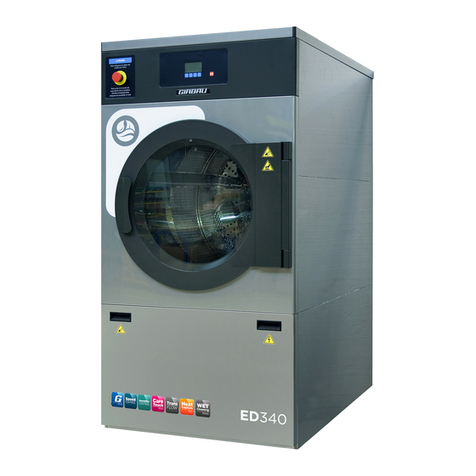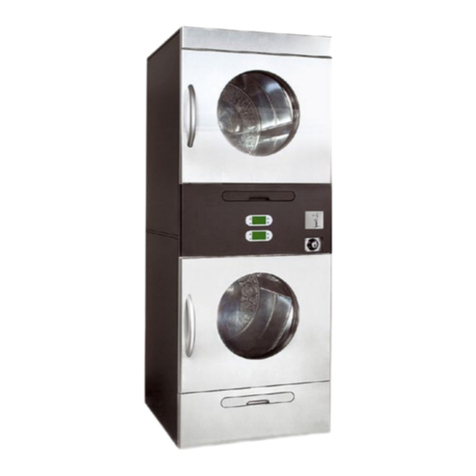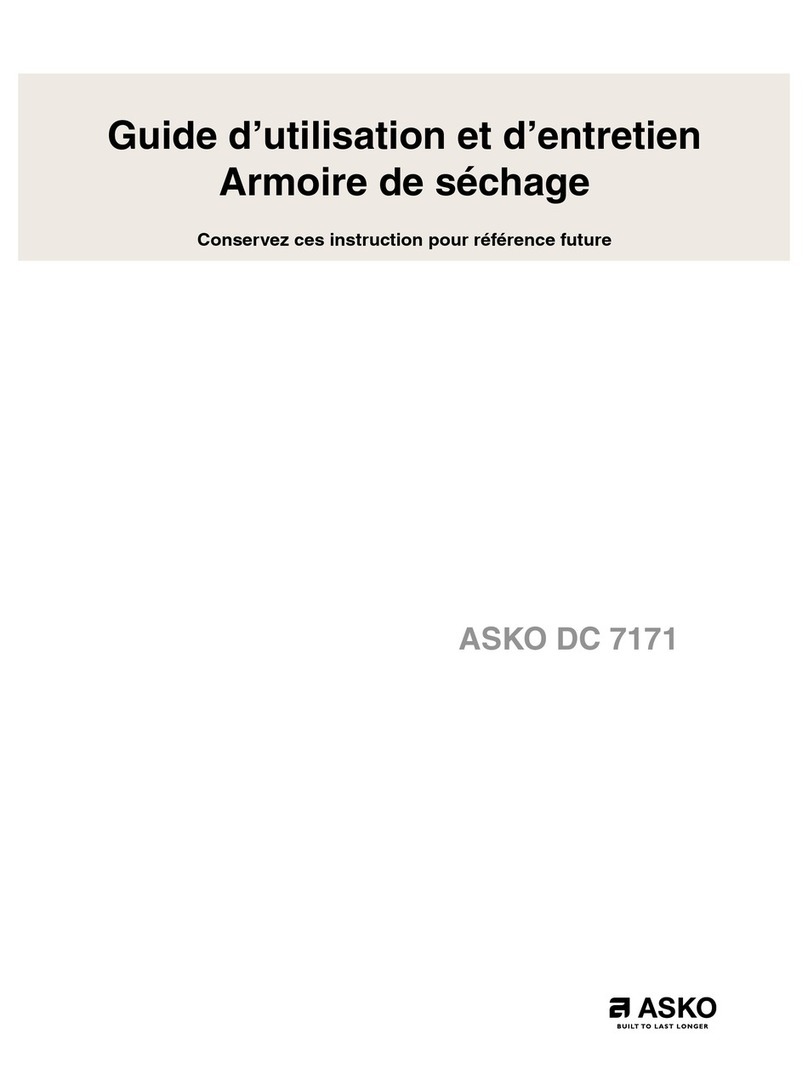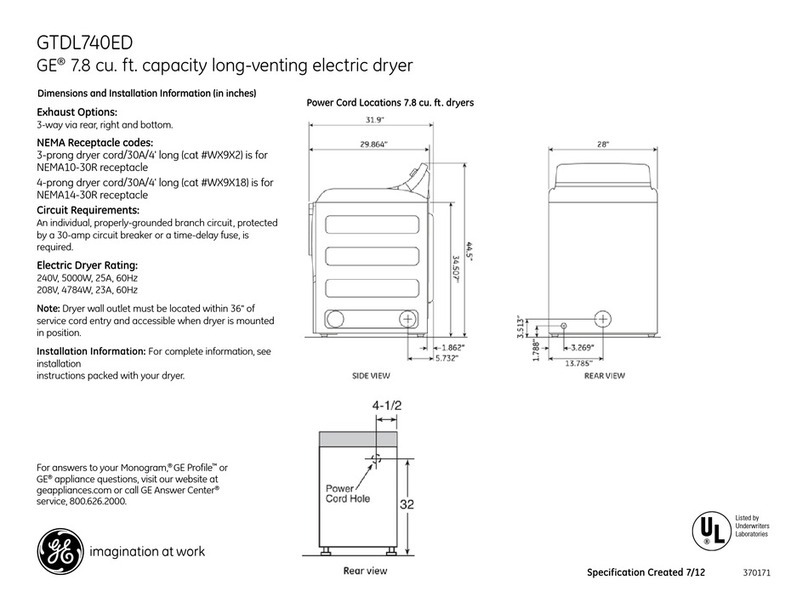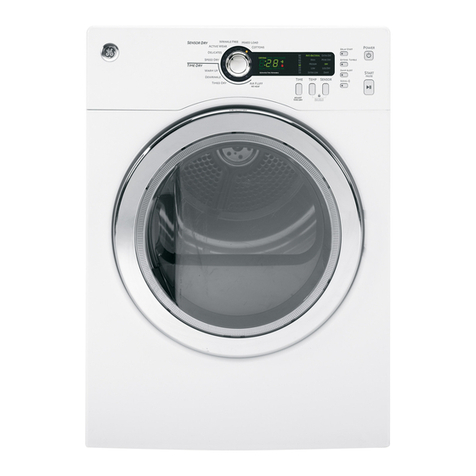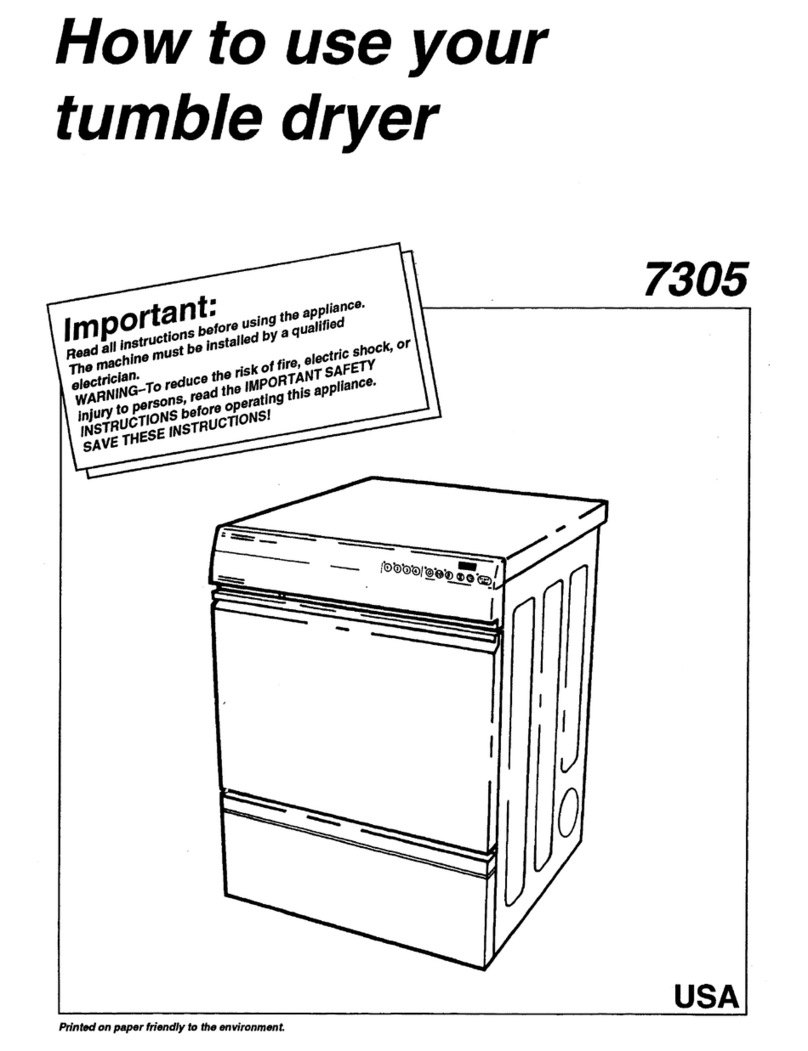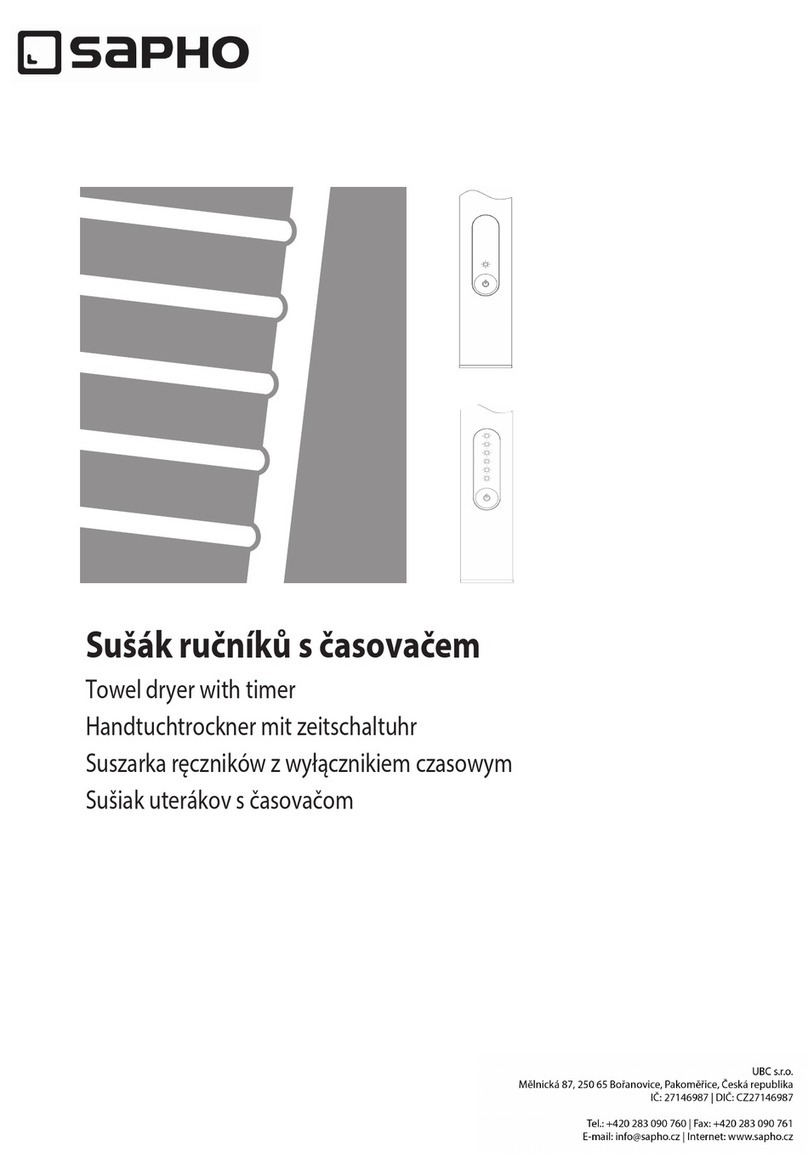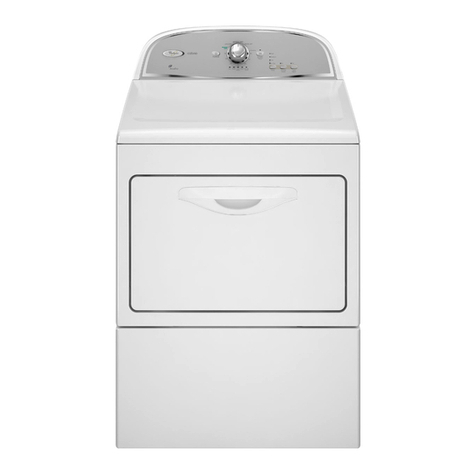GIRBAU ED Series Operating manual

Code no. 576074
Rev. nº 03/0418
Model
From Machine No.
ED260
ED340
ED460
ED660
ED900
ED1250
2,215,001
2,240,001
2,265,001
2,290,001
2,480,001
2,470,001
Operating and Maintenance
Instruction manual for
PROFESSIONAL ED dryers
GIRBAU, SA
Crta de Manlleu, km. 1
08500 VIC (Barcelona) • SPAIN
National sales:
T.(+ 34) 902 300 359
International sales:
T.(+ 34) 938 862 219
Service:
T.(+ 34) 902 300 357
www.girbau.es
For USA and CANADA:
CONTINENTAL GIRBAU Inc.
2500 State Road 44
WI 54904 Oshkosh • USA
Tel. 1(920) 231-8222
www.continentalgirbau.com
EN
PROFESSIONAL
ED260/ED340
ED460/ED660
ED900/ED1250

Contents 2
Code no. 576074
Rev. nº 03/0418
CONTENTS
SAFETY INSTRUCTIONS ...................................................................................................................................... 5
1. PRIOR INFORMATION ....................................................................................................................................... 9
1.1. General description of the machine .................................................................................................................. 9
1.1.1. Functional features ................................................................................................................................. 9
1.2. EC declaration of conformity ............................................................................................................................ 9
1.3. Dos and don'ts in using the machine ................................................................................................................ 9
2. MANAGEMENT AND CONTROL SYSTEM ..................................................................................................... 11
2.1. Control panel .................................................................................................................................................. 11
2.1.1. User interface ....................................................................................................................................... 11
2.1.2. Functions assigned to the multifunction key ........................................................................................ 11
2.2. Interpreting the main on-screen icons ............................................................................................................ 12
3. INTERVENTION MODES ................................................................................................................................. 13
4. PROGRAM EXECUTION MODE ...................................................................................................................... 14
4.1. Connecting the energy sources ...................................................................................................................... 15
4.2. Load the machine ........................................................................................................................................... 15
4.2.1. Guidelines for the prevention of risks in loading and unloading ........................................................... 15
4.3. Selecting and starting a program .................................................................................................................... 16
4.3.1. Program groupings ............................................................................................................................... 16
4.3.2. Order that the programs are displayed on the screen ......................................................................... 16
4.3.3. Starting a program ................................................................................................................................ 17
4.3.4. End of the program ............................................................................................................................... 17
4.3.5. Standby mode at end of program ......................................................................................................... 17
4.3.6. Running a program. Description and examples of the screens ........................................................... 18
4.3.7. Information key ..................................................................................................................................... 19
4.4. Altering the drying programs .......................................................................................................................... 20
4.4.1. Using advanced settings ...................................................................................................................... 20
4.4.2. Specific modification of the program being executed .......................................................................... 20
4.4.3. Automatic speed control. AUTOSPEED .............................................................................................. 21
4.5. Manual program. Definition and use............................................................................................................... 22
4.6. Stop modes ..................................................................................................................................................... 22
4.6.1. Normal stopping ................................................................................................................................... 22
4.6.2. Stop due to opened door ...................................................................................................................... 22
4.6.3. General Stop ........................................................................................................................................ 23
4.6.4. Emergency stop button ........................................................................................................................ 23
4.7. Pre-set programs ............................................................................................................................................ 24
4.7.1. Content of the pre-set programs .......................................................................................................... 24
4.7.2. Explaining the functions of the preset programs .................................................................................. 24
5. EDIT MODE ....................................................................................................................................................... 25
5.1. Defining editing concepts ............................................................................................................................... 25
5.2. Programming mode menus ............................................................................................................................ 26
5.3. General observations ..................................................................................................................................... 26
5.3.1. Two operating modes ........................................................................................................................... 26
5.3.2. Programming a phase .......................................................................................................................... 26
5.3.3. Program diagrams ................................................................................................................................ 28
5.4. Creating a new program ................................................................................................................................. 29
5.5. Editing a pre-existing program ........................................................................................................................ 32
5.5.1. Modifying a phase of a pre-existing program ....................................................................................... 32
5.5.2. Copying a program ............................................................................................................................... 32
5.5.3. Deleting a program ............................................................................................................................... 33
6. SYSTEM TOOLS MODE ................................................................................................................................... 34
6.1. Accessing and moving between the intervention areas ................................................................................. 34

Contents 3
Code no. 576074
Rev. nº 03/0418
6.2. Menus that make up the System Tools mode. ............................................................................................... 35
7. CONFIGURATION MENU ................................................................................................................................. 36
7.1. Settings ........................................................................................................................................................... 36
7.1.1. General settings ................................................................................................................................... 36
7.1.2. Options: ................................................................................................................................................ 37
7.1.3. Tables: .................................................................................................................................................. 38
7.2. Access codes .................................................................................................................................................. 38
8. INFORMATION MENU ...................................................................................................................................... 39
8.1. General information ........................................................................................................................................ 39
8.2. Counters ......................................................................................................................................................... 39
9. PERSONAL PROTECTION WEAR .................................................................................................................. 40
10. TROUBLESHOOTING .................................................................................................................................... 41
10.1. Troubleshooting operation problems ............................................................................................................ 41
10.2. Alarms ........................................................................................................................................................... 42
10.2.1. List of main alarms ............................................................................................................................. 43
10.2.2. Troubleshooting .................................................................................................................................. 43
10.3. Freeing a person trapped inside the machine .............................................................................................. 49
11. USER MAINTENANCE INSTRUCTIONS ....................................................................................................... 50
11.1. Clean and check the lint filter ....................................................................................................................... 51
11.2. Cleaning the machine ................................................................................................................................... 51
11.3. Checking safety mechanisms ....................................................................................................................... 52
11.3.1. Checking the door opening safety device .......................................................................................... 52
11.3.2. Checking the emergency stop ............................................................................................................ 53
11.4. Preventative maintenance programme......................................................................................................... 54
11.5. Cleaning the inside of the inverter ................................................................................................................ 55
11.6. Troubleshooting operation problems ............................................................................................................ 57
11.7. General checks ............................................................................................................................................. 57
11.8. List of most common spare parts ................................................................................................................. 58
12. REMOVAL FROM SERVICE AND DISMANTLING ....................................................................................... 59

Safety instructions 4
Code no. 576074
Rev. nº 03/0418
DANGER!
WARNING
FOR YOUR SAFETY THE INFORMATION IN THIS MANUAL MUST BE FOLLOWED TO MINIMIZE THE
RISK OF FIRE OR EXPLOSION OR TO PREVENT PROPERTY DAMAGE, PERSONAL INJURY OR
DEATH.
DO NOT STORE OR USE GASOLINE OR OTHER FLAMMABLE VAPORS AND LIQUIDS IN THE VICINITY
OF THIS OR ANY OTHER APPLIANCE.
WHAT TO DO IF YOU SMELL GAS:
• Do not try to light any appliance.
• Do not touch any electrical switch; do not use any phone in your building.
• Clear the room, building or area of all occupants.
• Immediately call your gas supplier from a neighbor's phone. Follow the gas supplier's
instructions.
• If you cannot reach your gas supplier, call the fire department.
INSTALLATION AND SERVICE MUST BE PERFORMED BY A QUALIFIED INSTALLER, SERVICE
AGENCY OR THE GAS SUPPLIER.
The following “FOR YOUR SAFETY” caution must be posted near the dryer in a prominent location:
FOR YOUR SAFETY
Do not store or use gasoline or other flammable vapors and liquids in the vicinity of this or any other
appliance.
IMPORTANT NOTE TO PURCHASER
Post in a prominent location instructions to be followed in the event the user smells gas. The information to be
posted shall be obtained by consulting with the local gas supplier.

Safety instructions 5
Code no. 576074
Rev. nº 03/0418
IMPORTANT SAFETY INSTRUCTIONS
1. Read all instructions before using the appliance.
2. Keep all instructions in an easily accessible place in order to resolve any queries, and in case of loss
request a new one from your dealer.
3. Dry linen that has been previously treated or washed in petrol, dry cleaning solvents or other flammable or
explosive substances. These substances give off vapours that could ignite or explode.
4. Do not allow children to play with or inside the machine. Do not allow children to play on or in the appliance.
Close supervision of children is necessary when the appliance is used near children.
5. Before the appliance is removed from service or discarded, remove the door to the drying compartment.
6. Do not reach into the appliance if the drum is moving.
7. Do not install or store this appliance where it will be exposed to the weather.
8. Do not tamper with controls.
9. Do not repair or replace any part of the appliance or attempt any servicing unless specifically recommended
in the user-maintenance instructions or in published user-repair instructions that you understand and have
the skills to carry out.
10. Do not use fabric softeners or products to eliminate static unless recommended by the manufacturer of the
fabric softener or product.
11. Do not use heat to dry articles containing foam rubber or similarly textured rubber-like materials.
12. Clean lint screen before or after each load.
13. Keep area around the exhaust opening and adjacent surrounding areas free from the accumulation of lint,
dust, and dirt.
14. The interior of the appliance and exhaust duct should be cleaned periodically by qualified service personnel.
15. Do not place items exposed to cooking oils in your dryer. Items contaminated with cooking oils may
contribute to a chemical reaction that could cause a load to catch fire.
16. DO NOT REMOVE any safety device OR MODIFY OR MANIPULATE any component or part of the
machine. DO NOT INSTALL any extra elements inside the machine.
17. Any part of the machine that is replaced may affect its operation and the user’s safety. For this reason, USE
ONLY THE MANUFACTURER’S ORIGINAL SPARE PARTS. Failure to comply with this warning can
cause serious accidents, malfunctions and the loss of the machine’s guarantee and certifications.
18. Failure to comply with or observe the legislation and regulations covering health, safety and prevention of
risks in the workplace applicable in the country where the machine has been installed, or actions contrary to
common sense, MAY CAUSE personal injury or even death to the user.
19. The machine should only be used for those purposes established by the manufacturer and following the
instructions for use set out in the instruction manuals. Any use not specified in the manuals may lead to
additional risks. Pay special attention to information headed DANGER, WARNING and PRECAUTION.
20. The room where the machine is located MUST comply with the environmental conditions (air venting,
temperature, humidity, etc.) specified in the technical specifications table. NEVER INSTALL THE
MACHINE IN ENVIRONMENTS where it will be splashed with water or where there is a very high level of
humidity in the atmosphere.
21. Clearly mark out danger areas and PREVENT public access to them when the machine is operating. Do not
expose yourself to drainage areas or to vapour, condensation, combustion gas or ventilation outlets.
22. All machines working at temperatures present a fire risk. Take EXTREME care: CLEAN the machine of
inflammable materials: lint, fluff, soot, etc. on a regular basis. KEEP the environment free of combustible
materials and PLACE suitable extinguishers near the machine in easily accessible places.
23. All installations required for the proper operation of the machine MUST be carried out by a duly accredited
Registered Installation Contractors (see Note 3), in compliance with the legal regulations applicable in the
country of use.
24. The machine MUST be commissioned by the Authorised Technical Service in the presence of the Customer
Technical Service (see Notes 2 and 4) or a responsible person appointed by the customer.

Safety instructions 6
Code no. 576074
Rev. nº 03/0418
25. This machine MUST BE USED by personnel who are properly trained in how to use it (see Note 1).
26. NEVER START THE MACHINE, OR USE IT, IF THE FOLLOWING ARE ABSENT, INCORRECTLY
POSITIONED OR MALFUNCTIONING:
COVERS (GUARDS) AND PROTECTIVE DEVICES
SAFETY DEVICES
CONTROL ELEMENTS
27. DO NOT USE the machine if you notice any abnormal noise or smell or if you suspect that the machine is
faulty or defective.
28. On completion of the day's work, TURN OFF the manual fluid supply valves and DISCONNECT the
electrical power. To avoid the risk of fire, DO NOT leave HOT AND DRY linen inside the dryers.
29. The inspections required by the regulations applicable to the country where the machine is being used must
be carried out. It is advisable to request an overall, detailed service of the machine by the Authorised
Technical Service every year (see Note 2).
30. WARNING!!
INSPECTION, MAINTENANCE OR REPAIR OPERATIONS
Before carrying out any action on the machine:
Close and mechanically lock the manual fluid supply valves.
Check that the bath has COMPLETELY drained, that no part of the machine is at a high temperature
and that no circuits or containers are under pressure.
Check that all the machine’s moving parts are halted or in their rest position. Securely fix all the
machine’s moving parts that could cause an accident.
To reduce the risk of electric shock:
COMPLETELY disconnect the machine from the mains power supply and take steps to prevent
accidental reconnection. TURNING OFF THE ON SWITCH OR PRESSING THE STOP KEY IS NOT
ENOUGH.
Disconnect the electrical connection of any circuit external to the machine; for example external dosing
equipment, central vending units, linen feeders or folders, etc. The electrical connection for these circuits
is independent of the machine’s electrical connection.
To prevent the risk of electrical discharge caused by residual voltage, wait at least five minutes before
removing any guard or cover from the machine.
Failure to follow these warnings may cause a serious accident.
31. CONTACT the Installation Contractors or the Authorised Technical Service (see Notes 3 and 2) in the event
of any doubt, anomaly or problem.
32. It is advisable to copy and enlarge the SAFETY INSTRUCTIONS and place them in a visible place in the
laundry.
33. THE MANUFACTURER ACCEPTS NO RESPONSIBILITY IF THESE SAFETY INSTRUCTIONS AND ALL
THE INFORMATION IN THE CORRESPONDING MANUALS ARE NOT FOLLOWED.
SAVE THESE INSTRUCTIONS.

Safety instructions 7
Code no. 576074
Rev. nº 03/0418
SYMBOLS USED IN MACHINE LABELLING
Electrical risk
Protective guard for elements carrying
an electric current.
High temperature risk
Handle with caution.
Use adequate protection.
Mechanical risk
Protective guard for moving parts.
Risk of inhaling harmful or irritant
vapours
Keep the doors/covers closed.
Use adequate protection.
Flame risk (only on some machines)
Protective guard for flame.
Risk of falling
Use proper access and safety methods.
Access prohibited
Refer to instruction
manual/booklet
SYMBOLS USED IN THIS MANUAL
Symbol used to highlight a possible
HAZARD, WARNING or NOTE.
This symbol is used to emphasise a
particular explanation.
TRANSLATION OF THE ORIGINAL MANUAL
NOTES:
(1) Trained personnel refers to those who have read and understood the Instruction Manual, who have been trained by the Authorised
Technical Service or by a representative of the customer present at the start-up who is familiar with the operation of the machine and is
authorised to use it.
(2) Authorised Technical Service (ATS) is one that has been recognised under contract and properly trained by the manufacturer.
(3) Registered Installation Contractors are those officially approved by the government of the country the machine is to be installed.
(4) Customer Technical Service (CTS) is one that has been authorised by the customer and which has sufficient basic technical knowledge
to correctly interpret and carry out the actions attributed to it in this manual. The manufacturer strongly recommends that the customer
should have its own technical service, particularly in laundries with large-scale machinery installations.

Safety instructions 8
Code no. 576074
Rev. nº 03/0418
IMPORTANT INSTRUCTIONS FOR USE AND PRESERVATION
1. INTENDED USE OF THE MACHINE AND INAPPROPRIATE USE. This machine is designed and intended
solely for processing fabrics washed in a water bath or that have been previously treated in these
conditions. Any use other than this is contraindicated without written authorisation from the manufacturer.
2. Maximum output, performance, reliability and durability are achieved when the machine is installed, used
and maintained correctly, and if a comprehensive and detailed service is carried out annually by the
Authorised Technical Service.
3. The machine’s MATERIALS that are in direct contact with the chemical products involved in treating the
linen are detailed in the manual.
4. The user must consult the supplier of the chemical products USED THROUGHOUT THE WHOLE LINEN
TREATMENT PROCESS regarding the risks associated with its products and their combination. It must be
confirmed that the products are not flammable, ARE MUTUALLY COMPATIBLE, and that they will not
cause oxidisation or deterioration of the machine or any injury to the people using them.
It should be noted that, under certain conditions of use, hypochlorite (bleach) generates chlorine gas.
Chlorine is a corrosive, oxidising substance which, at high concentrations and temperatures, damages
stainless steel and elastomers.
This same effect can also be caused by other strongly oxidising agents, including ozone.
5. FOLLOW the treatment recommendations for each fabric indicated by its manufacturer. THE
MANUFACTURER OF THE MACHINE accepts no responsibility for damage caused by inappropriate
treatment of a fabric.
6. Periodically CLEAN the outside of the machine to prevent damage to its metal parts. This will improve
safety and extend its life. To clean the machine, use water and detergent. Rinse with a damp cloth and
then dry off. To remove accumulated lint, use a suitable vacuum cleaner. Water jet or pressurised steam
cleaning is prohibited.
7. NEVER use aggressive products to clean the machine or the premises. There are products on the market
that give off highly corrosive vapours.
8. If the machine is left idle for long periods of time, it must be thoroughly PROTECTED from humidity and
temperature variations.
9. Faults arising from improper machine operation may VOID THE WARRANTY.
10. When asking for information on your machine, MENTION the model and serial number. This information
can be found on the specification nameplate incorporated into the machine.
With every machine, the manufacturer provides all the necessary technical information and documents required
for its use. KEEP IT IN GOOD CONDITION.
.

Prior information 9
Code no. 576074
Rev. nº 03/0418
1. PRIOR INFORMATION
1.1. General description of the machine
This manual applies to PROFESSIONAL CONTROL dryer models ED260, ED340, ED460, ED660, ED900 and
ED1250 in all their different heating and control system versions.
Main features of the dryer
Front-loading rotary dryer.
A stainless steel drum with large perforation area consisting of pressed holes.
Double glazed drum access door with air cavity (an option without air cavity is also available).
Lint filter that has a large surface area and is easy to access for cleaning.
Pressure switch for air flow leak detection.
Availability of up to 10 pre-set programs and 40 programmable programs.
Programming, copying, modifying and deleting menus in graphic mode.
Multiple controls that ensure the safe use of the machine.
1.1.1. Functional features
Dryer operation controlled by microprocessor.
Control of the temperature, drying time, drum rotation speed and linen wetness.
Availability of up to 10 pre-set programs and 40 programmable programs.
Programming, copying, modifying and deleting menus. These menus are displayed graphically to aid in
understanding the various operations.
Multiple controls that ensure the safe use of the machine.
1.2. EC declaration of conformity
The Installation Instruction Manual for the ED dryers contains a copy of the EC declaration of conformity.
1.3. Dos and don'ts in using the machine
CAUTION!
APPROPRIATE USE:
THIS MACHINE HAS BEEN CONCEIVED AND DESIGNED FOR THE INDUSTRIAL DRYING OF LAUNDRY
ITEMS WASHED IN WATER FREE FROM INFLAMMABLE OR EXPLOSIVE PRODUCTS. ANY USE
OTHER THAN DESCRIBED, CARRIED OUT WITHOUT WRITTEN AUTHORISATION FROM THE
MANUFACTURER, WILL BE TAKEN AS INAPPROPRIATE TO THE TERMS OF USE.
CAUTION!
INADVISABLE USE
It is totally prohibited to:
Operate the machine without the covers and guards correctly in place and secured.
Dry linen that has been previously treated or washed in petrol, dry cleaning solvents or other flammable or
explosive substances. These substances GIVE OFF VAPOURS that could ignite or explode.
Iron fabrics or fibres at temperatures above those recommended by the manufacturer of the material.
Dry articles of linen containing components unable to withstand the drying temperatures.
Disconnect the power supply until the cooling-down cycle has fully completed, EXCEPT IN AN
EMERGENCY.
The machine should not be used without covers or guards being fitted, or if any indication of faults,
deterioration or malfunction is detected.

Prior information 10
Code no. 576074
Rev. nº 03/0418
DANGER!
RISK OF SPONTANEOUS COMBUSTION
Because of the temperature of the linen, there is a potential risk of spontaneous combustion of the laundry load
inside the dryer.
To avoid the risk of spontaneous combustion, it is very important to follow these instructions:
Finish off drying programs with the cooling phase and do not remove the load until the cycle is completely
finished.
Once the drying cycle has finished or in situations where there is a power failure, remove the linen quickly
from inside the dryer.
Do not allow lint to accumulate in critical areas of the machine. Lint is readily flammable.
No washing machine can completely remove oils from fabrics. Never dry articles of linen that are stained
with oil. Never dry articles of linen containing rubber. Use the dryer ONLY to dry fabrics washed in water.
DANGER!
SPECIFIC WARNINGS FOR DRYERS WITH ELECTRIC HEATING
If the machine is at a high temperature and the fan stops or the power supply is disconnected, the heat
accumulated in the heater box is released through the grille in the top cover as hot air. Therefore:
Never obstruct this ventilation grille.
Do not place any object or substance on this cover.
Do not touch the dryer’s top cover.
DANGER!
SPECIFIC WARNINGS FOR GAS-HEATED DRYERS
When stopping the machine, always shut off the manual gas stopcock. Always turn off the gas heating before
stopping the machine.
DANGER!
SPECIFIC WARNINGS IN PROCESSES FOR DRYING MOPS
Some chemicals used in cleaning processes with mops are inflammable and are not easily removed during the
washing of mops.
For this reason it is advisable to:
Never dry mops that have not previously been washed in a water bath.
Ensure that the processes of washing the mops completely eliminates the residual chemicals that they are
impregnated with.

Management and control system 11
Code no. 576074
Rev. nº 03/0418
2. MANAGEMENT AND CONTROL SYSTEM
2.1. Control panel
User interaction devices on the dryer
A.- LCD display. Displays all the operating
information.
B.- Multifunction keypad. Allows interaction
with the machine.
C.- key. Key for stopping the program.
D.- Emergency stop. Red button with lock
situated in a visible and accessible location
on the machine (select models only).
2.1.1. User interface
Enables the user to interact with the different operations run by the dryer.
A.- Display. General overview of menus,
programs and functions.
B.- Titles and values bar. Indicates the titles and
values that are a feature of the program.
C- Multifunction keypad. Its function varies
depending on the working menu.
D.- Function indicator bar. Displays the function
assigned to the corresponding key.
E.- Stopping the program. Consult the stop
modes in Section 4.6.
2.1.2. Functions assigned to the multifunction key
Confirm key
Back to previous menu
Move to the right
Information
Move to the left
Cancellation
Scroll up
Halt alarm
Scroll down
Silence alarm
Confirmation/Modification
Screen in text mode. Used in the SETTINGS mode menus. The language for the texts can be selected in
the settings menu. Refer to Section 7.1.

Management and control system 12
Code no. 576074
Rev. nº 03/0418
2.2. Interpreting the main on-screen icons
ICON
EXPLANATION
Access to the drying programs
Access to program editing
Access to tools menu
Temperature indicator
Heating activated
Heating not activated
Heating turned off
Drying mode by detection of relative moisture
Moist drying mode
Dry drying mode
Extra-dry drying mode
Phase/program time indicator
Deleting a program
Copying a program
Modifying an existing program
Creating a new program
Editing a program

Intervention modes 13
Code no. 576074
Rev. nº 03/0418
3. INTERVENTION MODES
The machine control is divided into THREE MAJOR OPERATION AREAS or user INTERVENTION MODES.
Each of the three modes is accessed through the MAIN MENU made up of three icons identifying each of the
modes.
Menu selection keys.
Confirming the selection.
Displaying in graphic mode. The icons selected in graphical mode are displayed highlighted against a dark
background.
PROGRAM EXECUTION MODE
Covers the functions or interventions aimed at:
Selecting and executing the different drying programs.
Accessing information about the different functions that the dryer is executing.
Specific modifications of the program being executed.
The information that appears on the screen during the execution of a program is in
graphic mode.
Information regarding this intervention mode: Chapter 4 on this manual.
PROGRAM EDIT MODE
Covers the functions or interventions aimed at:
Changing the name of the preset programs.
Making a new drying program or modifying the contents of an existing program (the contents of
the factory preset programs cannot be changed).
Copying an existing program and modifying it.
Deleting the programs programmed by the user from the machine’s memory.
The information that appears on the screen in the program management menu is in
graphic mode.
Information regarding this intervention mode: Chapter 5 on this manual.
SYSTEM TOOLS MODE
This area offers specific menus for CONFIGURING THE SYSTEM.
Among other features:
Configuring operation settings.
Setting the system clock.
Controlling access and security codes.
Information about the characteristics and life of the machine.
The information in this area is in text mode.
Information regarding this intervention mode: Chapters 6 - 8 on this manual.
Start

Running a program 14
Code no. 576074
Rev. nº 03/0418
4. PROGRAM EXECUTION MODE
CAUTION!
THE REGULATIONS FOR SAFETY AT WORK AND ACCIDENT PREVENTION MUST BE METICULOUSLY
FOLLOWED.
DO NOT USE THE MACHINE WITHOUT SUITABLE TRAINING AND EXTENSIVE OPERATING
KNOWLEDGE.
NEVER START OR USE THE MACHINE IF ANY OF THE FOLLOWING ARE MISSING, INCORRECTLY
POSITIONED OR MALFUNCTIONING:
COVERS (GUARDS) AND PROTECTIVE DEVICES
SAFETY DEVICES
CONTROL ELEMENTS.
BEFORE HANDLING THE LINEN INSIDE THE DRYER, WAIT UNTIL THE DRUM HAS COMPLETELY
HALTED.
IF THE LINEN IS AT A HIGH TEMPERATURE, PROTECT HANDS WITH THERMALLY INSULATED
GLOVES.
DANGER!
MECHANICAL RISKS
To avoid the risk of being caught up in the machine’s moving parts it is essential for hair to be
tied up and suitable fitted clothing to be worn.
Jewellery must not be worn.
Do not use the machine without all the cover and safety guards correctly in place.
Disconnect the power supply and close the gas supply valves and other sources of heating before
removing any form of protection.
ELECTRICAL RISKS
It is essential for the machine to be connected to external protection (earthed).
HIGH TEMPERATURE RISKS
Do not remove any safety guards without first making sure the machine is cool (<35 ºC / 90 ºF).
Do not put the hands anywhere near the exposed surface of the drum, particularly, the laundry
output area or the heating circuit elements.
Wear heat insulating gloves to protect the hands from the continuous contact with hot laundry.
FIRE RISKS
Lint and soot are highly flammable substances.
It is essential to avoid these building up inside the machine and the exhaust ducting running from
the machine to the outside.
To achieve this, all the places likely to collect lint and soot must be regularly cleaned (e.g.:
covers, exhaust ducting, filter, fan, etc.).
Also keep the area around the machine free from lint and any other inflammable materials or
substances.
Remove the linen from inside the dryer without delay. This will prevent creases in the fabric and
reduce the risk of spontaneous combustion.

Running a program 15
Code no. 576074
Rev. nº 03/0418
DANGER! (AUSTRALIA ONLY)
According to A.G.A specs:
Do not use or store flammable materials in the appliance storage drawer or near this appliance.
Do not spray aerosols in the vicinity of this appliance while it is in operation.
Do not modify this appliance.
This appliance shall not be used to dry off solvents or drycleaning fluids.
4.1. Connecting the energy sources
Turn on the dryer’s external power supply switch.
Switch on the dryer breaker switch (machines with breaker switch).
Open the manual gas inlet valve (gas heated dryers only).
4.2. Load the machine
Group the fabrics to be dried into homogeneous loads. Avoid mixing articles of different thicknesses and
moisture level, since this will slow down the drying to the detriment of fine materials.
To aid the movement of air through the inside of the drum, the load must not exceed the nominal capacity.
Nominal capacity by models (Load ratio 1/20):
CAPACITY
MODEL
ED260
ED340
ED460
ED660
ED900
ED1250
kg
13
17
23
33
45
62.5
lb
28.7
37.5
50.7
72.8
99.2
137.8
Do not dry linen with accessories that cannot be machine dried.
It is not advisable to mix whites with other colours.
It is not advisable to mix items of different fabric or thicknesses, especially when programs with moisture
control are used.
Check labels and/or characteristics of the garments or fabrics to be dried and choose a program in
accordance with these characteristics.
Ensure that the dryer’s filter is clean. Remember that a dirty filter reduces the dryer’s performance.
Open the door and load the machine.
4.2.1. Guidelines for the prevention of risks in loading and unloading
See the dryer measures and the heights of the work areas in the corresponding Installation Instruction
Manual.
To prevent risks due to high temperature, hands must be protected with heat-insulated gloves.
Follow the legislation and regulations for health and safety in the workplace in force in the country where the
machine has been installed.

Running a program 16
Code no. 576074
Rev. nº 03/0418
4.3. Selecting and starting a program
Select the RUNNING PROGRAMS menu on the main screen.
4.3.1. Program groupings
The dryer has 50 programs grouped into three types:
Programs that can be programmed by the user: Programs that are empty of content, where programs can
be created and stored. (Maximum number of programs that can be programmed: 40.
Preset programs: Ten preset programs with different drying cycles. Only their names can be changed, not
their content.
Manual program. A program that allows the user to program a drying cycle for a single use only, and which
is NOT stored in the dryer’s memory. Its appearance on the program list is optional and can be selected in
the OPTIONS menu from the Tools menu (see Section 7.1.2).
4.3.2. Order that the programs are displayed on the screen
The machine displays four programs per screen in the following order of appearance:
Top four: List of the four most commonly used programs (either preset or programmed), arranged by
frequency of use. On starting up the dryer for the first time the screen displays the first four pre-recorded
programs. As different programs are run, these are displayed in the top four positions.
Manual program: If the manual program display is enabled and is not used, it will be positioned after the list
of the top four.
Programs created by the user: List of the created programs. If no programs have yet been created, the
machine displays the preset programs directly.
Preset programs: List of ten programs preset in the machine’s memory.

Running a program 17
Code no. 576074
Rev. nº 03/0418
4.3.3. Starting a program
Select the desired program using the and
selection keys. The information related to the
program selected is displayed at the top right of the
screen:
drying temperature (70 ºC in attached image)
drying stage time (25 minutes in attached image) /
degree of drying (according to the setting set in the
program).
Press the START PROGRAM key. After a few seconds the
drum will begin to rotate.
Fig. 4.1
If the ADVANCED USAGE SETTINGS option has been enabled, see Section 4.4.1.
See examples of executing a program in Section 4.3.6.
4.3.4. End of the program
Once the cooling stage has ended, the machine informs the user of the end
of the drying program acoustically and on screen.
Fig. 4.2
Precautions at the end of the drying program
N.B. It is very important:
To remove the linen from inside the dryer without delay. This will
prevent creases in the fabric and reduce the risk of spontaneous
combustion.
To clean the lint filter on a regular basis. Lint prevents extraction and
reduces the performance of the dryer. Use the indication for periodic
cleaning of the lint filter in the general settings Configuration menu.
(Section 7.1.1). Further information about cleaning the filter can be
found in Chapter 11.
The final temperature of the linen can be high. Protect hands with heat-
insulated gloves.
4.3.5. Standby mode at end of program
If the load is not removed immediately on completing the drying program and corresponding cooling phase, the
machine will remain in standby mode. In this state, the machine will rotate the drum every 30 minutes for 1
minute and run the extractor.
The maximum time in standby mode is 120 minutes.
Start 70ºC/25’

Running a program 18
Code no. 576074
Rev. nº 03/0418
4.3.6. Running a program. Description and examples of the screens
For further information, see comments on the various functions that the dryer executes during the program in
Chapter 5: Edit mode.
During the course of the drying program, a series of informative screens will appear describing the functions that
the dryer is executing. Information about functions is displayed by means of icons.
Two examples of drying programs are shown below:
Example 1: length of the drying stage in accordance with set time.
Example 2: length of the drying stage in accordance with linen moisture level control.
These examples are based on the EASY operating mode.
Example 1: Length of the drying stage in accordance with set time
Select the desired program using the and keys. Then press to start the program
(Fig. 4.1).
Once the program has started, the screen will display
the programmed temperature (Fig. 4.3/A), the internal
temperature of the machine (Fig. 4.3/B), as well as the
heating icon in activation phase (Fig. 4.3/C).
Fig. 4.3
During the drying stage, the remaining drying time is
displayed (Fig. 4.4/A), and depending on the type of
drying selected, the Autospeed or speed change
icon appears (Fig. 4.4/B).
Fig. 4.4
When the dryer enters the cooling phase the
programmed cooling temperature is displayed (Fig.
4.5/A), the internal temperature of the machine (Fig.
4.5/B), as well as the time remaining until the end of
the cooling phase (Fig. 4.5/A).
Fig. 4.5
Once the cooling stage has ended, the machine informs the user of the end of the drying cycle acoustically and
on screen.
02 Polyester
02 Polyester
Cool down

Running a program 19
Code no. 576074
Rev. nº 03/0418
Example 2: Length of the drying stage in accordance with linen moisture level control
For machines with moisture detector only.
Select the desired program using the and keys. Then press to start the program
(Fig. 4.1).
Once the program has started, the screen displays the
programmed temperature (Fig. 4.6/A), the internal
temperature of the machine (Fig. 4.6/B), the heating
icon in activation phase (Fig. 4.6/C), the moisture level
programmed (Fig. 4.6/E) and the time elapsed (Fig.
4.6/D).
Fig. 4.6
During the drying stage, the drying time elapsed is
displayed (Fig. 4.7/A), and depending on the type of
drying selected, the Autospeed or speed change
icon appears (Fig. 4.7/B).
Fig. 4.7
When the moisture level detected by the dryer is equal to the level programmed, the dryer will enter the
cooling stage and end of the cycle (see Example 1).
4.3.7. Information key
The display of the INFO key is subject to the INFO VIEW option being selected in the menu (Section 7.1.2).
If the key is pressed while a program is running, the machine will provide information concerning the
operation of the machine and the content of the program.
Contents of the Information menu:
Input temperature
Output temperature
Moisture
Drying time limit
Drying time
Rotation speed
Electrical power used by the inverter.
DANGER!
ONCE THE PROGRAM HAS ENDED, THE LINEN AND THE INSIDE OF THE DRUM MAY BE AT
A HIGH TEMPERATURE.
PROTECT HANDS WITH HEAT-INSULATED GLOVES.
01 Towels
01 Towels

Running a program 20
Code no. 576074
Rev. nº 03/0418
4.4. Altering the drying programs
4.4.1. Using advanced settings
The ADVANCED USAGE SETTINGS can be enabled from the configuration menu. (See Section 7.1.2).
Enabling advanced settings allows direct access to three modes of execution that modify the contents of the
selected program.
Running the program in basic mode: Running the program without any alteration.
Running the program in soft mode: Indicated for drying delicate items. Reduce the mechanical action and
controls the temperature to obtain gentle drying.
Running the program in eco mode: Reduces energy consumption.
Running in reduced load mode : Indicated when using the dryer with reduced loads.
Once the program to be executed has been selected, the following screen is displayed:
Left key: Sequential selection of soft mode,
eco mode, no selection.
Right key: Enabling or disabling half load
mode.
Confirm and start program.
Back to previous menu
Important information about EXECUTION MODES
The program EXECUTION MODES are available in all the programs except the manual program.
The eco and soft modes are mutually exclusive.
The eco and soft modes may slightly increase the length of the drying stage.
The half load mode is compatible with any of the eco and soft modes.
While the program is running, an indication of the EXECUTION MODE activated is displayed on the screen.
4.4.2. Specific modification of the program being executed
During the execution of a program, it is possible to modify the following program values: The alteration made
only applies to the program that is running. Once the program has ended, the content will return to the original
values.
Values that can be altered and the range of alteration
Setting
Unit
Programmable
values
Notes
Changing the drying time. This option is only
displayed in programs with control by length of
time.
It does not appear in programs with control by
moisture level.
Drum Speed: each step alters the speed of
the drum by 2 rpm.
The information key can be used to check the
actual speed of the drum (Section 4.3.7).
Drying time
min
2 - 120
Drying temperature
ºC
40 - 90
ºF
104 - 194
Drum rotation speed
rpm
25 – 45
Advanced settings
This manual suits for next models
6
Table of contents
Other GIRBAU Dryer manuals
Popular Dryer manuals by other brands
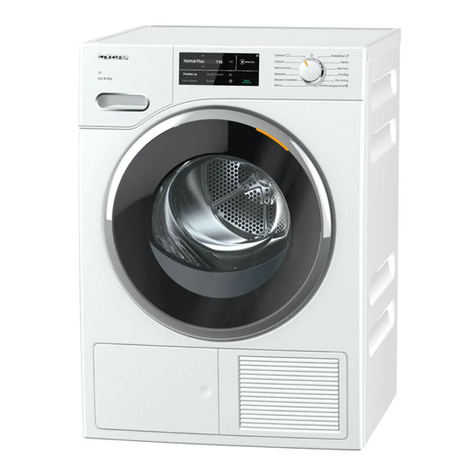
Miele
Miele TWJ 660 WP operating instructions
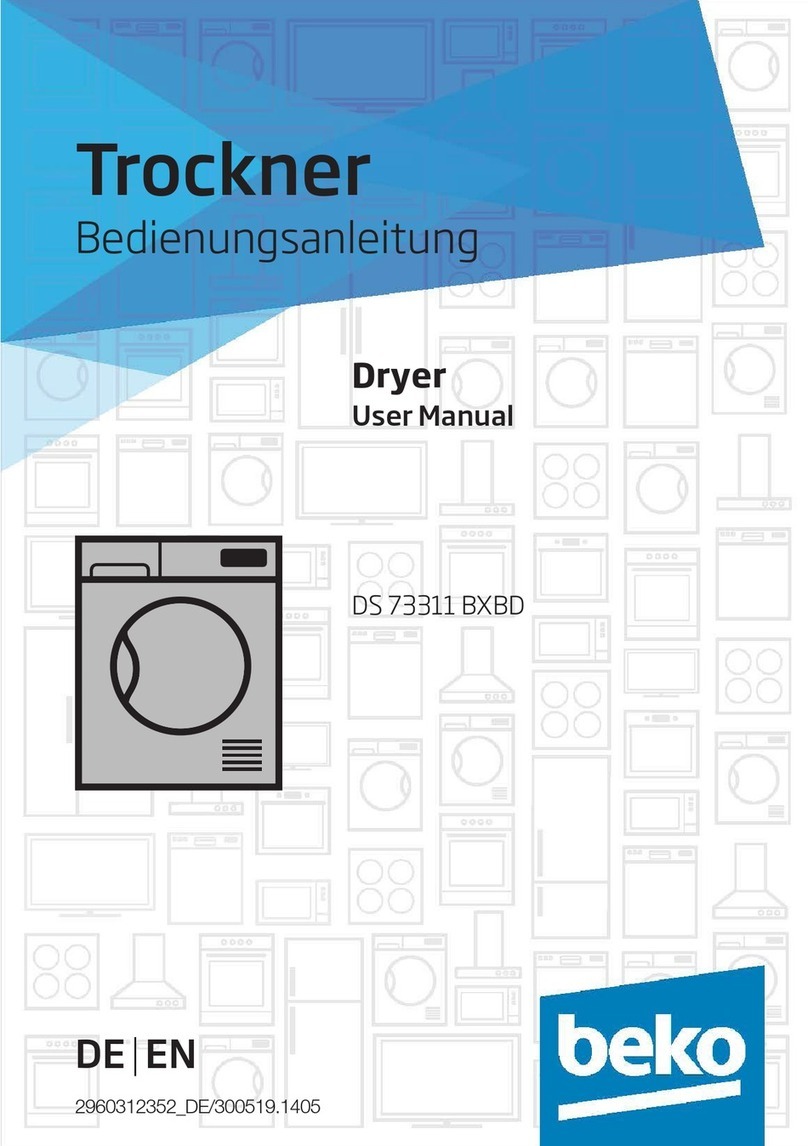
Beko
Beko DS 73311 BXBD user manual

Bosch
Bosch WTN85200ES Installation and operating instructions
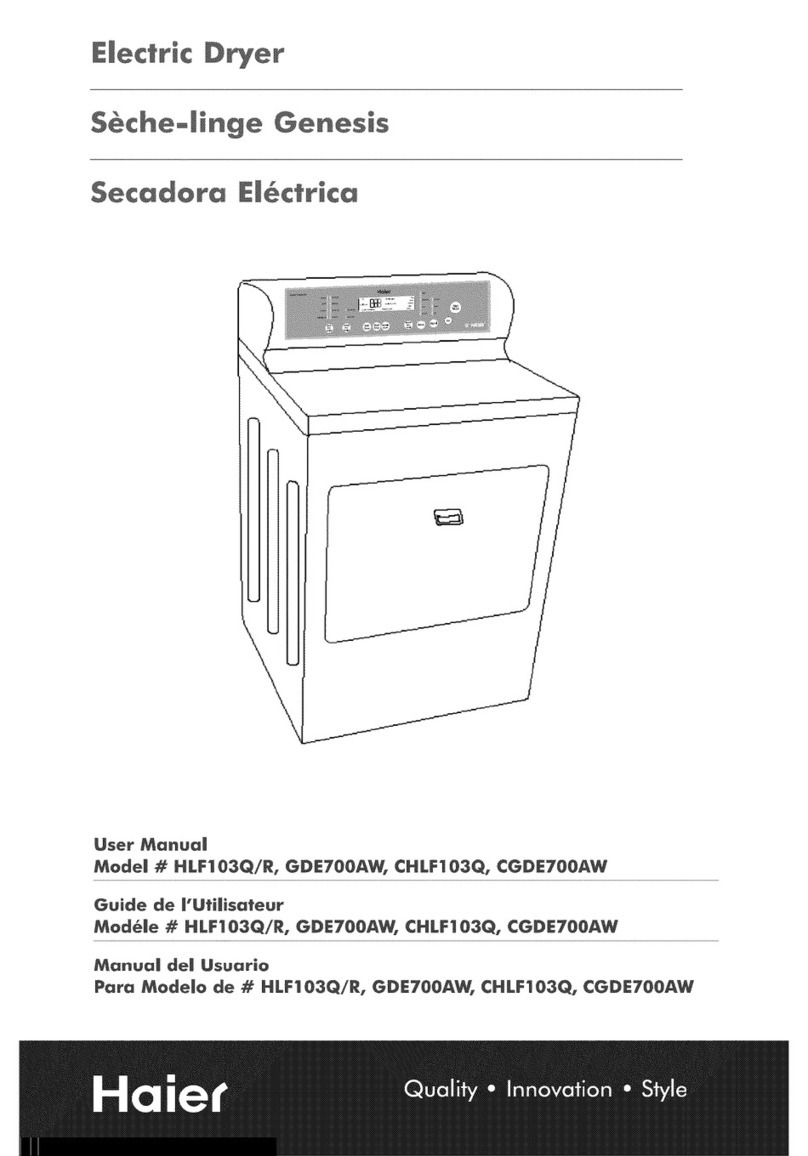
Haier
Haier Ginesis HLF103Q user manual
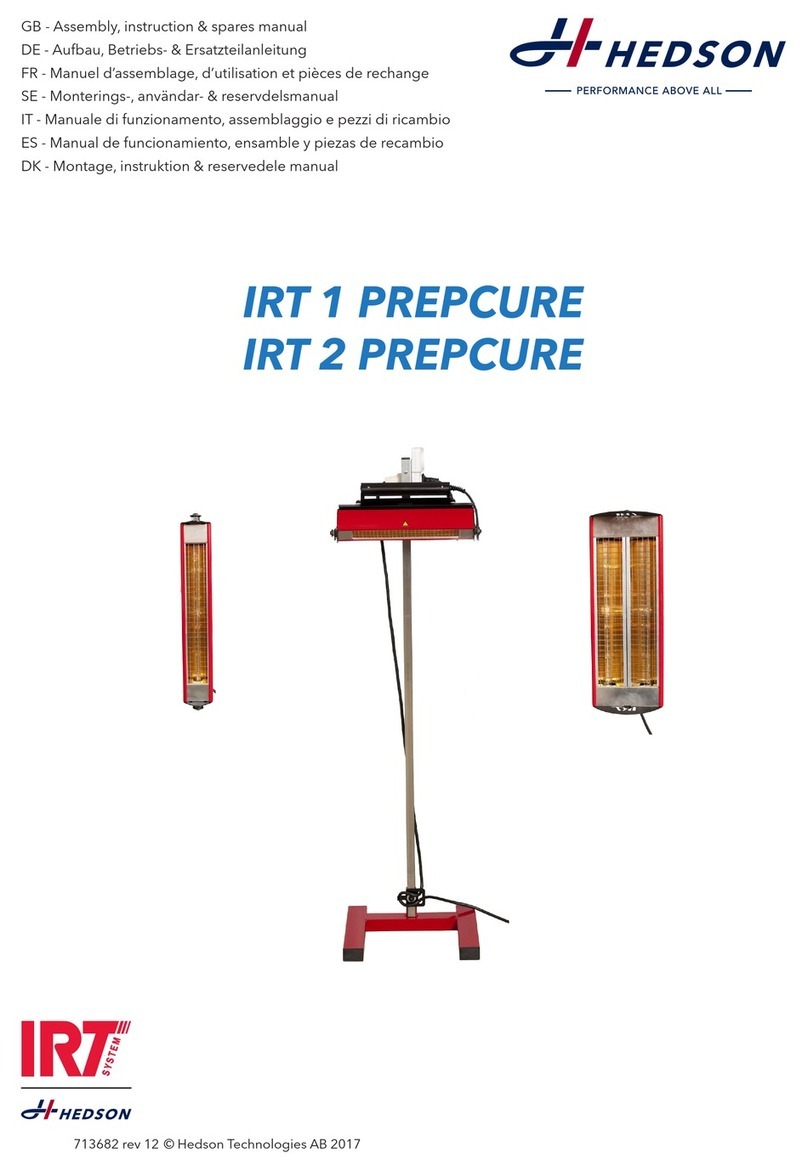
Hedson
Hedson IRT 1 PREPCURE Assembly, instruction & spares manual

Fisher & Paykel
Fisher & Paykel DE4024P1 Quick reference guide

